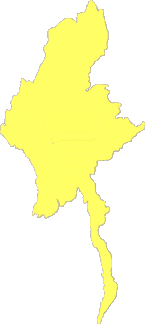|
 |
This
little girl wears a layer of thanaka, a thick pasty cosmetic worn by
many women and children from Burma for both beauty and protection from the sun.
Each group in Burma has their own unique set of patterns and designs for clothes and other fabrics. Here
a Chin man wears a suit in the pattern of his community.
This Karenni (or Kayah) woman shows some of her traditional dress. Note the weighted ear pieces that
stretch a large hole in her earlobes.
(scroll over picture)
Craftwork is familiar to the Burmese in the form of jewelry and accessories. At left is a bead necklace
created by a local Chin woman. At right is shoulder bag common to Burma decorated in the Karen tradition.
Most of the Karen continue to wear their traditional shirts like those seen here
and. Around the community, many still wear their traditional longyi, a sarong wrap common throughout
Burma (but the younger generation much prefers their holey Levis.)
Karenni men sometimes wear these woven pants that came to define their identity for the British colonials.
The name 'Karen-ni' comes from the Burmese for "Red Karen" which they were labelled as because of the unique red outfit.
This Kachin couple wore their traditional outfits at
their wedding. The woman's dress also includes a red woven apron and
leggings
(scroll over picture)
Traditional tools and items of the Chin include straps for holding harvesting baskets and bulbous pipes for smoking.
|
